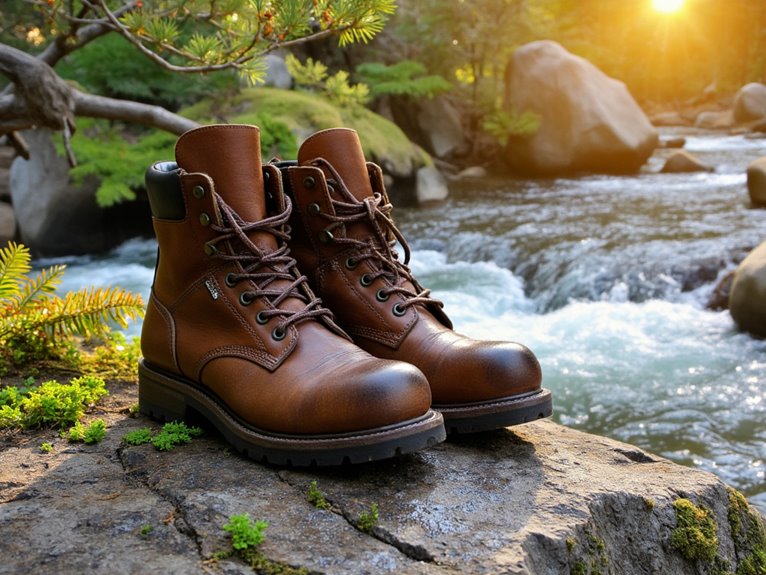Boots That Can Survive a Month Off-Grid: What to Look For
You’ll need boots with full-grain leather construction and triple-stitched seams to withstand month-long abuse. Look for Gore-Tex or eVent waterproof membranes with breathable panels, aggressive Vibram outsoles with self-cleaning treads, and antimicrobial treatments like Agion® to prevent bacterial growth. Proper fit requires sizing up half a size and testing with hiking socks. Target 1.5-2.5 pounds per boot maximum, since every ounce translates to significant energy expenditure over extended missions. Understanding these technical specifications guarantees your gear matches the demanding requirements ahead.
We are supported by our audience. When you purchase through links on our site, we may earn an affiliate commission, at no extra cost for you. Learn more. Last update on 30th December 2025 / Images from Amazon Product Advertising API.
Notable Insights
- Choose full-grain leather or nubuck construction with double-reinforced stitching and seam sealing for maximum durability and water resistance.
- Select boots with Gore-Tex or eVent membranes for waterproofing while maintaining breathability through semi-gusseted tongues and mesh panels.
- Prioritize sophisticated traction systems with varied lug patterns and dual-compound rubber soles for reliable grip across multiple terrains.
- Opt for lightweight designs (1.5-2.5 pounds) to reduce energy expenditure and prevent fatigue during extended off-grid missions.
- Ensure antimicrobial treatments and moisture-wicking materials are integrated to prevent bacterial growth and maintain foot health during prolonged wear.
Essential Construction Features for Extended Wilderness Use
Durability becomes paramount when you’re weeks away from civilization with only the gear on your back. Smart materials selection forms the foundation of expedition-worthy boots. Full-grain leather provides superior abrasion resistance and natural water repellency, while nubuck leather offers similar durability with enhanced flexibility.
Synthetic composites reduce weight but sacrifice longevity—a poor trade-off for extended wilderness use.
Advanced stitching techniques determine structural integrity under stress. Double or triple stitching with high-strength nylon threads reinforces critical seams. Bar-tacking at stress points prevents tear propagation. Seam sealing blocks water ingress during river crossings or prolonged wet conditions. Seam-sealed waterproofing prevents moisture penetration at critical stitch points where boots typically fail during extended expeditions.
Reinforced heel counters and toe boxes maintain boot shape after hundreds of miles. Protective rands shield the upper from rock scrapes. Quality hunting boots with 98% ratings demonstrate the reliability standards needed for extended wilderness expeditions.
Effective lacing systems ensure optimal fit and performance throughout demanding wilderness conditions. Just like outdoor jackets, boots should feature adjustable elements for a customizable fit that adapts to changing foot conditions during long expeditions. These construction elements work together, creating boots that’ll function reliably throughout month-long expeditions.
Waterproof Protection Without Sacrificing Breathability
Water protection and breathability represent competing priorities in boot design—achieving both requires sophisticated membrane technology and strategic material placement. Gore-Tex and eVent membranes dominate this space, preventing external water intrusion while allowing moisture vapor from sweat to escape. Gore-Tex SURROUND® technology enhances this balance through 360-degree ventilation systems.
You’ll face inevitable trade-offs. Waterproof membranes inherently limit airflow compared to ventilated shoes—typical Gore-Tex liners score around 1/5 for breathability. Heavy leather boots with waterproof liners feel stuffier than lightweight nylon models due to material density.
Strategic design features help optimize performance. Semi-gusseted tongues reduce water entry while ventilation channels improve air exchange. Features like mesh tongues improve breathability while maintaining dryness, making these boots suitable for crossing streams and handling wet conditions.
Combining mesh panels with waterproof membranes maximizes airflow in non-critical areas while maintaining protection where needed most.
Achieving Proper Fit and Comfort for Long-Term Wear
While waterproofing protects your feet from external moisture, achieving proper fit and comfort determines whether you’ll complete your mission or return home with debilitating injuries.
Your fit assessment must account for natural foot expansion during extended activity. Try boots with your intended hiking socks to guarantee realistic sizing. The heel should lock securely without slipping, preventing blisters and instability on uneven terrain.
Proper boot fitting with hiking socks prevents heel slippage and blisters during challenging terrain navigation.
Toe box volume must accommodate foot swelling without crowding. EVA midsoles provide essential shock absorption, reducing joint fatigue during prolonged wear. Dual-density construction balances cushioning with stability for efficient movement.
Padded ankle collars cushion pressure points around vulnerable areas. Breathable liners prevent moisture buildup that leads to fungal infections. Synthetic materials often require minimal break-in compared to leather alternatives.
Your long term comfort depends on balancing rigid support with natural foot flexibility during extended off-grid operations. Most waterproof models require sizing up half to one size due to the bulk of the waterproof membrane. Target boots under 2 pounds per pair to prevent unnecessary fatigue during long-distance hiking missions.
Traction Systems for Multiple Terrain Types
Proper fit becomes meaningless when your boots can’t grip the terrain beneath them.
Multi terrain adaptability requires sophisticated traction systems that perform across ice, mud, rock, and loose surfaces. Your boots need varied lug patterns—sharp lugs penetrate mud while flatter designs grip rocky terrain. Self-cleaning treads shed debris to maintain grip optimization throughout your journey.
For winter conditions, you’ll want removable traction devices. Metal spike systems like Kahtoola EXOspikes provide 12 carbide tips per foot for solid ice. Steel bead assemblies offer multi-directional grip while self-clearing snow buildup.
Remove metal devices on bare rock to prevent trail damage.
Advanced soles use dual-compound rubber—harder edges for durability, stickier centers for steep ascents. This combination guarantees reliable traction whether you’re crossing frozen streams or steering through loose scree. Specialized tread patterns enhance grip on varied surfaces, improving stability on uneven terrain during extended backcountry adventures.
For optimal performance across varied terrain, your outsoles should feature 3-7mm lug depth to provide adequate grip without compromising stability on different surfaces.
Build Quality That Withstands Extreme Conditions
The foundation of survival-grade boots lies in their ability to endure punishment that would destroy ordinary footwear. Material resilience starts with full-grain leather construction, providing superior abrasion resistance against rocks, thorns, and debris. You’ll need double-reinforced stitching using thick threads that won’t unravel under stress.
Structural engineering principles apply directly to boot construction. Look for integrated shank systems spanning heel to toe, creating rigid platforms that distribute weight evenly. Reinforced toe caps and heel counters protect high-impact zones from repeated strikes.
| Component | Standard Grade | Survival Grade |
|---|---|---|
| Stitching | Single thread | Double reinforced |
| Leather | Split grain | Full grain |
| Hardware | Basic eyelets | Anti-corrosive |
Waterproof membranes prevent material degradation while seam sealing eliminates weak points where water infiltration typically destroys boots from within.
Tactical and Survival-Specific Boot Features
When you’re operating in survival situations, you need boots that adapt quickly to changing conditions and maintain performance over extended periods. Quick lacing systems eliminate the time-consuming process of threading traditional eyelets, allowing you to secure your boots in seconds using speed laces, BOA dial systems, or zipper mechanisms that maintain consistent tension throughout your mission.
Anti-odor technology becomes critical during multi-day operations when you can’t change socks regularly—antimicrobial treatments and moisture-wicking materials prevent bacterial growth that causes foot infections and compromises your mobility when escape routes depend on healthy feet. Aggressive tread patterns provide the stability and grip necessary for navigating slippery ground and loose surfaces that are common in off-grid environments.
Since off-grid conditions often involve stream crossings and wet terrain, waterproof membranes with seam-sealed construction ensure your feet stay dry during prolonged exposure to moisture that could otherwise lead to hypothermia or debilitating foot conditions.
Quick Lacing Systems
While standard criss-cross lacing serves basic needs, quick lacing systems represent a tactical advantage that can mean the difference between mission success and failure in critical situations. You’ll find several advanced options that enhance lacing functionality beyond traditional methods.
| System Type | Adjustment Speed | Key Advantage |
|---|---|---|
| BOA Dial | Instant micro-adjustment | Glove compatibility |
| Speed Laces | 3-5 seconds | Maintains tension |
| Elastic Locks | One-handed operation | Disability-friendly |
| Ladder Lacing | Moderate setup | Superior ankle support |
Quick lacing benefits include uniform pressure distribution and rapid donning capabilities. Speed lacing systems maintain secure hold under dynamic conditions while eliminating re-tightening needs. BOA’s micro-adjustable dial allows precise fitting even with thick gloves. These systems reduce tripping risks and improve mission readiness. When selecting lacing systems, prioritize slip-resistant outsoles to complement your quick-adjustment capabilities for maximum safety during demanding off-grid operations.
Anti-Odor Boot Technology
Extended missions in challenging environments create the perfect breeding ground for odor-causing bacteria, making anti-odor technology essential rather than optional for survival boots.
You’ll need boots featuring Agion® antimicrobial treatment, which actively inhibits microbial growth within boot linings. These anti-odor treatments work by embedding silver-based compounds into textile fibers, preventing bacterial colonization that causes persistent odors.
Look for boots with antimicrobial linings like 5.11® SlipStream Waterproof technology, which provides microbial resistance while maintaining moisture protection.
Under Armour’s military boots incorporate similar anti-odor tech for extended duty cycles. Removable antimicrobial insoles, such as Insite® Contoura® systems, allow periodic cleaning and replacement.
Effective moisture-wicking linings complement these treatments by reducing sweat accumulation. Combined with breathable upper materials and proper ventilation features, these technologies maintain boot hygiene during month-long off-grid operations.
Weight Considerations for Month-Long Expeditions
During month-long expeditions, every ounce on your feet translates to significant energy expenditure that compounds over thousands of daily steps.
You’ll experience measurably increased fatigue when wearing boots in the 3-4 pound range compared to lighter alternatives weighing 1.5-2.5 pounds per pair.
Understanding how boot weight affects your energy reserves and perceived pack load becomes critical for maintaining endurance throughout extended off-grid operations.
Energy Conservation Benefits
When you’re planning a month-long off-grid expedition, every gram on your feet translates directly to energy expenditure that’ll either sustain you or drain your reserves. Research shows adding just 0.5 kg per foot increases energy expenditure by 8%. Weight at your extremities demands disproportionately more metabolic cost than torso-carried loads.
Boot efficiency becomes critical during sustained trekking. Lightweight materials like Vibram soles and synthetic uppers reduce overall weight without sacrificing performance. Proper fit eliminates internal foot movement, preventing energy loss from friction and biomechanical inefficiency.
Well-designed toe boxes allow natural toe splay, optimizing walking mechanics. Shock-absorbing midsoles preserve muscle energy by reducing impact forces. Breathable liners manage moisture, preventing thermoregulation energy drain. Similar to how polyester-elastane blends in outdoor gear provide durability while maintaining flexibility, boot materials must balance protection with weight efficiency.
Every design element should prioritize minimizing metabolic cost while maintaining essential protection and durability. Flexible materials like stretchy synthetics adapt to foot shape changes during extended expeditions, reducing pressure points that waste energy through compensatory gait adjustments.
Frequently Asked Questions
What’s the Average Lifespan of Waterproof Membranes in Harsh Outdoor Conditions?
You’ll find waterproof technology in boots typically lasts 5-20 years depending on conditions. Membrane durability varies considerably – liquid-applied membranes last 5-10 years while high-quality options can reach 20-30 years outdoors.
Should I Break in New Boots Before a Month-Long Survival Situation?
Absolutely break in new boots before any month-long survival situation. You’ll need proper boot fitting and extensive comfort testing through at least 20 miles of walking to prevent painful blisters and potential footwear failure.
How Do I Properly Dry Wet Boots Without Damaging the Materials?
You’ll want proper boot care using gentle drying techniques: remove insoles, stuff with newspaper, use fans for air circulation, and avoid direct heat sources that’ll crack leather or damage waterproof materials.
On a final note
You’ve now got the technical framework for selecting boots that’ll handle month-long wilderness expeditions. Focus on full-grain leather or synthetic uppers with waterproof-breathable membranes. Confirm proper fit with 10-15mm toe room and quality insole support. Choose aggressive lug patterns for varied terrain. Prioritize double or triple-stitched construction with reinforced stress points. Don’t compromise on weight versus durability—your feet will carry you through thirty days of demanding conditions.

